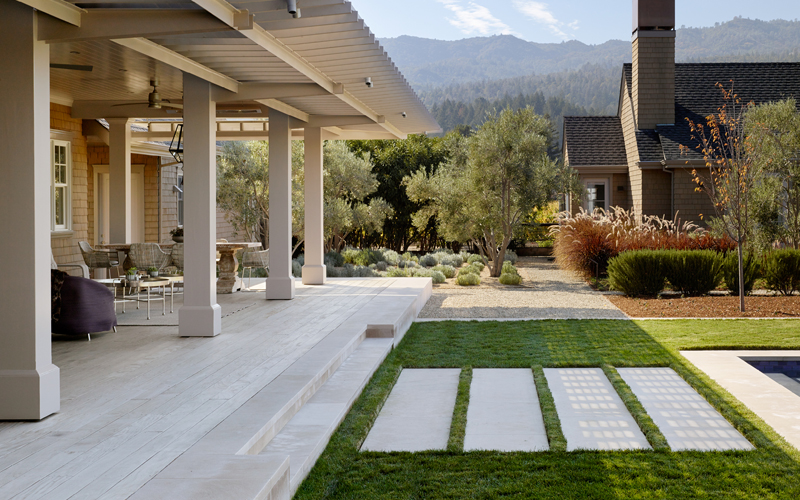Professional Practice
Using Low-Impact Materials: Permeable Surfaces
 The site's impervious surfaces where reduced by almost 70% with gravel paths and drought-tolerant planting. ASLA 2014 Professional Residential Design Honor Award. Vineyard retreat, Napa Valley, California / Scott Lewis Landscape Architecture.
The site's impervious surfaces where reduced by almost 70% with gravel paths and drought-tolerant planting. ASLA 2014 Professional Residential Design Honor Award. Vineyard retreat, Napa Valley, California / Scott Lewis Landscape Architecture. Rainfall picks up contaminants from impervious surfaces such as asphalt and concrete streets, driveways, and other pathways, which further contribute to water pollution. In comparison, increasing a site’s permeable surfaces allows for natural filtration and reduces the costs associated with adding stormwater management systems.
Permeable surfaces increase evapotranspiration, filtration and infiltration, and mitigate elevated water temperatures caused by contact with impervious surfaces. Permeable surfaces mitigate and control stormwater runoff by allowing water to pass through into the underlying soils. This kind of natural filtration process is the most effective way of eliminating water contaminants and pollutants.
Soil on residential properties can be degraded and compacted after years of development. Often times, thin layers of turf are rolled out over degraded soil, leaving the grass roots with no soil to grown into. The lawn will need a lot of fertilizer and water to survive, and the thin veneer of grass does not help capture any stormwater. Homeowners can use soil remediation techniques like subsoiling and adding soil amendments to improve water absorption, promote plant root establishment, and increase surface permeability.
Landscape architects can design residential properties to increase a site’s permeability with additional vegetation and soils and limit hardscapes by using porous materials like gravel and mulch.
More Resources
Permeable Pavers
Organizations
The Sustainable SITES Initiative™ (SITES®)
Depave Project
Resources
Reduce Impervious Surfaces, RecycleWorks, County of San Mateo
Richmond’s Green Alleys, The DIRT, American Society of Landscape Architects
What Makes a Green Street, The DIRT, American Society of Landscape Architects
“Handbook of Biophilic City Planning and Design,” Timothy Beatley, Island Press, 2016
Permeable Materials, Paths for All, Scottish Government
Designing with Soils, The Dirt, American Society of Landscape Architects
Using Health Soils to Manage Stormwater, The Dirt, American Society of Landscape Architects
Government Resources
Permeable Alleys, City of Chicago
Green Alley Handbook, City of Chicago
Permeable Surfaces, Florida Field Guide to Low Impact Development, University of Florida
Permeable Pavers and Re-Vegetation, Department of Energy & Environment, D.C.
The Avalon Green Alley Network Demonstration Project, Los Angeles Trust for Public Land
Projects
Vineyard Retreat, Napa Valley, California
Scott Lewis Landscape Architecture
Cambridge Permeable Driveway, Cambridge, Massachusetts
Julie Moir Messervy Design Studio
The Crack Garden, San Francisco, California
CMG Landscape Architecture
Alleé de Berlin Spandau, Paris, France
Espace Libre
Permeable Pavers
The Sustainable SITES Initiative™ (SITES®) strongly encourages permeable over impervious surfaces. Where hardscapes are needed permeable pavers, or pavement with high porosity, can be used to help reduce stormwater runoff and water infiltration into the ground. Permeable pavers can also trap pollutants that would otherwise enter local water sheds. Permeable paving can allow up to 80 percent of annual rainfall to infiltrate the underlying soil. Residential driveways and walkways can incorporate permeable materials while still maintaining a high-level of aesthetic quality. Often, these materials are also more reflective, which can help decrease the heat island effect.
Source: Permeable pavement, Green Building Alliance; Fact Sheet: Permeable Paving, Metropolitan Area Planning Council
Organizations
Pavement Interactive
Interlocking Concrete Pavement Institute
Pervious Pavement
Resources
Sustainable Paving in Use, Interpave
Permeable Paving, Green Building Alliance
Permeable Paving, Landscaping Network
Research
“Permeable Pavements,” Permeable Pavements Task Committee, LEED AP Bethany Eisenberg, P.E. Kelly Collins Lindow, David R. Smith, American Society of Civil Engineers, 2015
"Porous Pavements (Integrative Studies in Water Management and Land Development)," Bruce K. Ferguson. CRC, 2005
Government Resources
Design criteria for permeable pavement, Minnesota Stormwater Manual
De-paving and Permeable Pavers, City of Philadelphia
Soak Up the Rain, Permeable Pavement, Environmental Protection Agency
Pervious Pavement, Environmental Services, City of Portland
Projects
Drs. Julian and Raye Richardson Apartments, San Francisco
Andrea Cochran Landscape Architecture